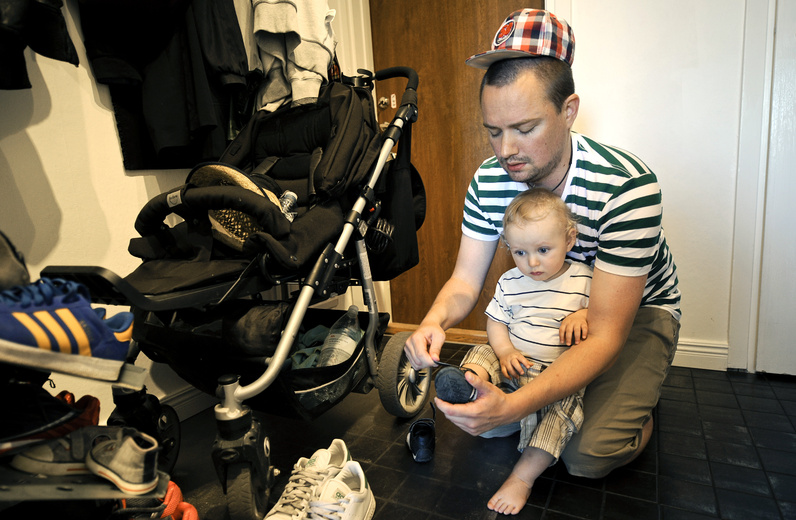STOCKHOLM — One of Henrik Holgersson’s friends laughed in his face when he said he was going to spend the better part of 2011 as a stay-at-home dad.
“What kind of a man are you?” the friend asked Holgersson, who works as a rigger for an event management company. But just about everyone else was positive. His employer and co-workers patted him on the back and wished him luck.
Holgersson took out 240 days of parental leave paid for by the government while his girlfriend, Jenny Karlsson, went back to her job as a real estate agent, after eight months at home with their son, Arvid.
“To take care of Arvid is a real fatherly thing to do. I think that’s very masculine,” said Holgersson, 34.
Holgersson’s experience isn’t unusual here, largely because Sweden encourages dads to stay at home with their newborn through a parental leave policy that is among the most generous in the world.
While more than a dozen countries now offer paid paternity leave, usually for a couple of weeks, Sweden subsidizes such leave for up to 14 months.
In Sweden, men pushing strollers – sometimes in twos or threes – have become part of the landscape. Baby changing stations are typically found in both men’s and women’s restrooms. Brawny men with Viking tattoos can be overheard discussing their “pappaledighet,” Swedish for “daddy leave,” over a pint in the pub.
Parents share 480 days of paid parental leave for each child, courtesy of the government. The benefits amount to 80 percent of the stay-at-home parent’s salary for the first 390 days, but no more than $135 a day. Thereafter, the amount drops to $30 a day for the remaining period.
Mothers are still taking more leave than fathers, but things are changing. In 2000, Swedish men took out only 12.4 percent of the parental leave; by last year, their share had nearly doubled to 23.1 percent, according to government statistics.
Despite widespread accord that the gap should close even more, Swedes have resisted calls by women’s rights activists for a compulsory 50-50 split.
However, Sweden has introduced incentives and rules to encourage men to take more time off with their babies.
To qualify for the maximum benefits, couples must split the parental leave so that one of them takes at least 60 days. (Single parents – male or female – can take out the full 480 days on their own.)
In addition, the government awards an “equality bonus” in the form of tax breaks that are proportional to how evenly couples split the parental leave. A household with a 50-50 division qualifies for a maximum deduction of $2,000.
Even at a time when Europe’s debt crisis is leading to painful austerity cuts across the continent, Sweden’s parental leave benefits appear safe. The economy is in relatively good shape, the budget is balanced and the government would commit political suicide if it scaled back on a program embraced by Swedes across all income brackets.
Foreigners often grow to appreciate it, too.
“I’m a huge fan of it. Here is the Swedish state subsidsdizing it for both parents. It’s almost too good to be true,” said Joel Sherwood, 35, an American living in Sweden who took more than six months off work to stay home with his daughter .
In the United States, there is no nationwide policy for government-subsidized parental leave. Some states, including California and New Jersey, have begun adopting such policies, but most parents are instead offered 12 weeks of unpaid leave. Some companies offer paid leave to their employees.
When state-subsidized parental leave was introduced in Sweden in 1974, women took nearly all of the parental leave. Men would wash dishes and fold the laundry, but child-rearing was considered a female domain.
Four years later, the government launched an ad campaign featuring national weightlifting champion Lennart Dahlgren to convince fathers you could stay home with a child and still be a real man. The poster of a smiling Dahlgren cradling a baby in his muscular arms remains an iconic image in Sweden.
A milestone was crossed in 1995 when the government started earmarking one month of parental leave benefits for each parent. Seven years later, it was increased to two months. Then came the equality bonus that further encouraged men to take daddy leave.
Roger Klinth, a researcher on gender issues at Linkoping University, said the legislative changes have helped normalize the idea of men caring for children in Sweden. “You’re not different anymore … you’re a part of the political system,” he said.
There is widespread agreement in Sweden that it doesn’t matter for a child’s development whether the primary caretaker is a man or a woman. Suggesting the contrary, especially in this gender-equality conscious country, can be controversial.
Child psychologist Eva Sternberg provoked an outcry last year when she blamed an increase in accidents involving toddlers on the growing numbers of stay-at-home fathers. Men are preconditioned through evolution to hunt and are not fit to replace women as caretakers, especially in the first year of a baby’s life, she argued in a newspaper column that drew a flood of angry responses.
“There is no special gene that makes women more suited to provide comfort and care than men, just like men are no better equipped to drive a car or lead a company,” replied Lars Ohly, leader of Sweden’s opposition Left Party.
Halfway through his leave, Holgersson noted a shift in his son’s behavior. When both parents were around, Arvid no longer ran to his mother when he hurt himself, but to his father. Holgersson felt as if he had become the caretaker parent, while Karlsson was the “fun” parent who Arvid liked to play with in the evening.
Toward the end of his parental leave, Holgersson had mixed feelings about going back to his job.
Though he looked forward to seeing his work colleagues, he knew he would miss the long days of casually playing with Arvid in the playground behind the apartment block.
Holgersson said he had forged an unbreakable bond with his son, learning to recognize Arvid’s huffs and snorts, and what they say about his mood – or about the contents of his diaper.
“How could you not want to spend time with this little one?” he said. “Yes, I could imagine having another one, too.”
Send questions/comments to the editors.




Success. Please wait for the page to reload. If the page does not reload within 5 seconds, please refresh the page.
Enter your email and password to access comments.
Hi, to comment on stories you must . This profile is in addition to your subscription and website login.
Already have a commenting profile? .
Invalid username/password.
Please check your email to confirm and complete your registration.
Only subscribers are eligible to post comments. Please subscribe or login first for digital access. Here’s why.
Use the form below to reset your password. When you've submitted your account email, we will send an email with a reset code.